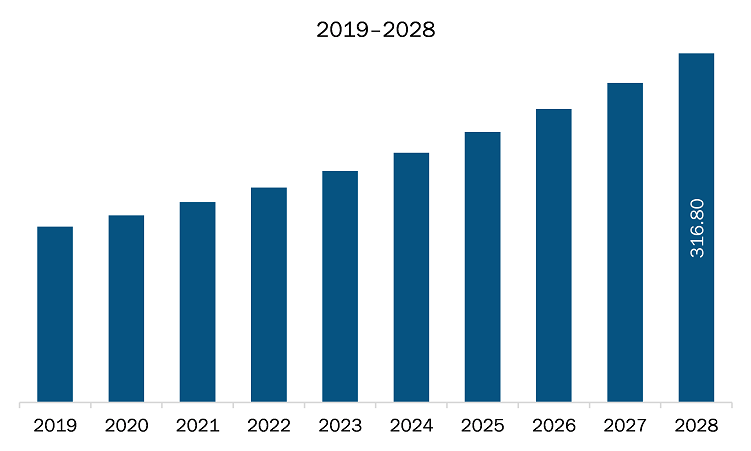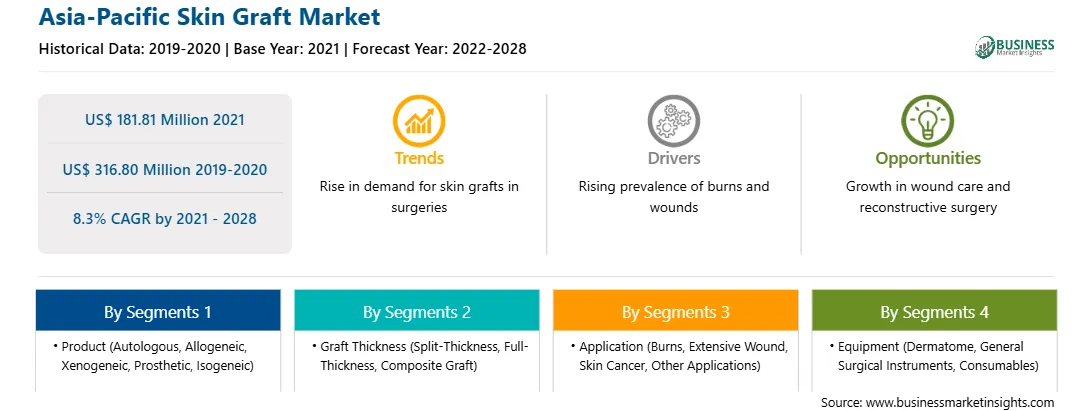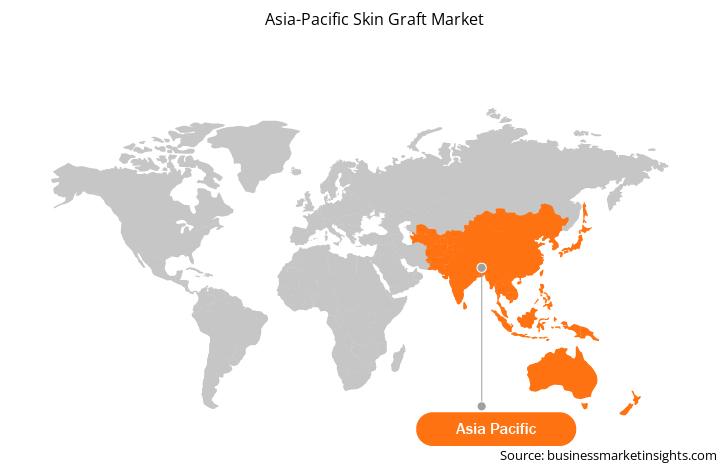Asia Pacific Skin Graft market comprises China, India, Japan, South Korea, Australia, and rest of Asia Pacific. In China, the growth of the market is attributed to rise in the number of cancer cases, rising emphasis on skin protection and development of new technologies for treatment of cancer. As per the report published in 2015, by American Cancer Society, in China, 4.3 million new cancer cases were diagnosed and more than 2.8 million deaths. Rising incidence of cancer has become one of the major economic concern for the country. On the other hand, growing geriatric population is expected to serve vital growth opportunities in coming year. The group of geriatric people are likely to diagnose with diabetes, and other wound through surgeries, fall downs and trauma and more. Among all these factors, diabetes is the primary factor leading to the maximum of diabetic foot ulcer. According to the International Diabetes Federation 2017, ~120 million people had diabetes in China. Additionally, according to the WHO, the diabetic population in China is expected to rise approximately 150 million by 2040. Moreover, the research studies and surveys reveal that in China, the average cost of hospitalization for diabetic foot ulcers (DFUs) is about US$ 2499.02 (i.e., 17,183 yuan). Thus, owing to the increasing incidences of diabetes, and increasing expenses to treat diabetic foot ulcer is likely to serve excellent growth opportunities for the market’s growth
The outbreak of the COVID-19 pandemic has come from China. The spread of infection has affected various Asian countries such as India, South Korea, Australia, Malaysia, Singapore, and others. The countries have reported maximum deaths and laboratory diagnosed positive patients. Amid the second wave of COVID-19, India is experiencing the highest number of cases with lack of healthcare infrastructure. Therefore, various businesses and economies have dramatically affected, resulting in crises. The major focus has been shifted to treat COVID-19 affected patients and the production of personal equipment products. On the other hand, Asian countries have a maximum number of burn cases. Countries such as India, Nepal, and Pakistan have ~ 1 million cases for burn wounds. According to the WHO, an estimated 180 000 deaths every year are caused by burns – the vast majority occur in low- and middle-income countries. In addition, in India, the State-run Victoria hospital affiliated to the Bangalore Medical College and Research Institute (BMCRI) was converted into a dedicated COVID-19 facility ever since the pandemic hit Karnataka in March, the functioning of the Mahabodhi Burns Ward in the hospital has not been hit. Despite the pandemic, the hospital continued to operate normally, following all COVID-19 precautions. With only one skin donation, the hospital was able to graft patches of skin from the patients themselves. Therefore, the outbreak of the COVID-19 pandemic is estimated to affect skin grafts negatively. It is estimated that it will continue to affect negatively in the coming few years.

Strategic insights for the Asia-Pacific Skin Graft provides data-driven analysis of the industry landscape, including current trends, key players, and regional nuances. These insights offer actionable recommendations, enabling readers to differentiate themselves from competitors by identifying untapped segments or developing unique value propositions. Leveraging data analytics, these insights help industry players anticipate the market shifts, whether investors, manufacturers, or other stakeholders. A future-oriented perspective is essential, helping stakeholders anticipate market shifts and position themselves for long-term success in this dynamic region. Ultimately, effective strategic insights empower readers to make informed decisions that drive profitability and achieve their business objectives within the market.

| Report Attribute | Details |
|---|---|
| Market size in 2021 | US$ 181.81 Million |
| Market Size by 2028 | US$ 316.80 Million |
| CAGR (2021 - 2028) | 8.3% |
| Historical Data | 2019-2020 |
| Forecast period | 2022-2028 |
| Segments Covered |
By Product
|
| Regions and Countries Covered | Asia-Pacific
|
| Market leaders and key company profiles |
|
The geographic scope of the Asia-Pacific Skin Graft refers to the specific areas in which a business operates and competes. Understanding local distinctions, such as diverse consumer preferences (e.g., demand for specific plug types or battery backup durations), varying economic conditions, and regulatory environments, is crucial for tailoring strategies to specific markets. Businesses can expand their reach by identifying underserved areas or adapting their offerings to meet local demands. A clear market focus allows for more effective resource allocation, targeted marketing campaigns, and better positioning against local competitors, ultimately driving growth in those targeted areas.

The skin graft market in APAC is expected to grow from US$ 181.81 million in 2021 to US$ 316.80 million by 2028; it is estimated to grow at a CAGR of 8.3% from 2021 to 2028. Surge in number of burn injuries; major application areas of skin grafts include burns and skin infections. There has been a rise in the number of burns and deaths caused due to burns. Similarly, according to the World Health Organization (WHO) statistics published in 2018, more than 180,000 deaths occurred due to burns. Most burns are reported from low or medium-income countries and Southeast Asia. With the rise in number of burn injuries, the demand for skin grafts to replace the damaged skin patch has increased during recent years. As per the National Burn Repository (NBR) statistics, in 2016, around 486,000 burn injuries received medical treatment. Over 60% of the hospitalizations related to burn injuries were admitted to 128 burn centers. Also, the cost of treatment has increased worldwide. Thus, the increasing number of injuries has contributed significantly to the growing demand for skin graft treatments, which is expected to continue during the forecast period leveraging the market’s growth.
Based on product, the market is segmented into autologous, allogeneic, xenogeneic, prosthetic, and isogeneic. In 2020, the autologous segment held the largest share of the market. Based on graft thickness, the market is divided into split-thickness, full-thickness and composite graft. In 2020, the split thickness segment held the largest share of the market. Based on equipment, the market is segmented into dermatome, general surgical instruments, consumables, and others
A few major primary and secondary sources referred to for preparing this report on the skin graft market in APAC are company websites, annual reports, financial reports, national government documents, and statistical database, among others. Major companies listed in the report are B. Braun Melsungen AG; Integra Life Sciences Corporation
The Asia-Pacific Skin Graft Market is valued at US$ 181.81 Million in 2021, it is projected to reach US$ 316.80 Million by 2028.
As per our report Asia-Pacific Skin Graft Market, the market size is valued at US$ 181.81 Million in 2021, projecting it to reach US$ 316.80 Million by 2028. This translates to a CAGR of approximately 8.3% during the forecast period.
The Asia-Pacific Skin Graft Market report typically cover these key segments-
The historic period, base year, and forecast period can vary slightly depending on the specific market research report. However, for the Asia-Pacific Skin Graft Market report:
The Asia-Pacific Skin Graft Market is populated by several key players, each contributing to its growth and innovation. Some of the major players include:
The Asia-Pacific Skin Graft Market report is valuable for diverse stakeholders, including:
Essentially, anyone involved in or considering involvement in the Asia-Pacific Skin Graft Market value chain can benefit from the information contained in a comprehensive market report.